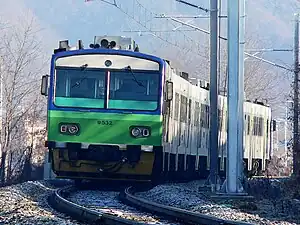| Korail Commuter Diesel Car | |
|---|---|
 | |
| In service | 1996–2023 |
| Manufacturer | Daewoo Heavy Industries |
| Constructed | 1996–1999 |
| Entered service | 1999 |
| Number built | 131 |
| Number in service | 10 |
| Capacity | 79–89 seats |
| Operators | |
| Specifications | |
| Train length | 20,900 mm (68 ft 7 in) |
| Width | 3,200 mm (10 ft 6 in) |
| Height | 4,200 mm (13 ft 9 in) |
| Wheel diameter | 860 mm (2 ft 10 in) |
| Wheelbase | 2,100 mm (6 ft 11 in) |
| Maximum speed | 120 km/h (75 mph) |
| Prime mover(s) | Cummins NT855-R4 |
| Engine type | Diesel |
| Cylinder count | 6 |
| Power output | 310 HP |
| Transmission | Voith T 211R |
| HVAC | TRU–0454H |
| Electric system(s) | AC 440V |
| Track gauge | 1,435 mm (4 ft 8+1⁄2 in) |
The Korail Commuter Diesel Car (Korean: 도시통근형 디젤 액압 동차) or CDC for short were commuter diesel multiple units in South Korea. They were introduced in 1996.[1] But due to the aging issue of the cars, they were fully retired on 17 December, 2023.
References
Bibliography
- Byun, Seong Woo (August 1999). 한국철도차량 100년사: 철도차량기술검정단 한국철도차량 100년사 편찬위원회 편찬 [100 Years of Korean Railway Vehicles: Compilation of the 100 Year History of Korean Railroad Vehicles by the Railroad Vehicle Technology Inspection Group] (in Korean). Seoul: Railroad Vehicle Technology Inspection Team.
This article is issued from Wikipedia. The text is licensed under Creative Commons - Attribution - Sharealike. Additional terms may apply for the media files.